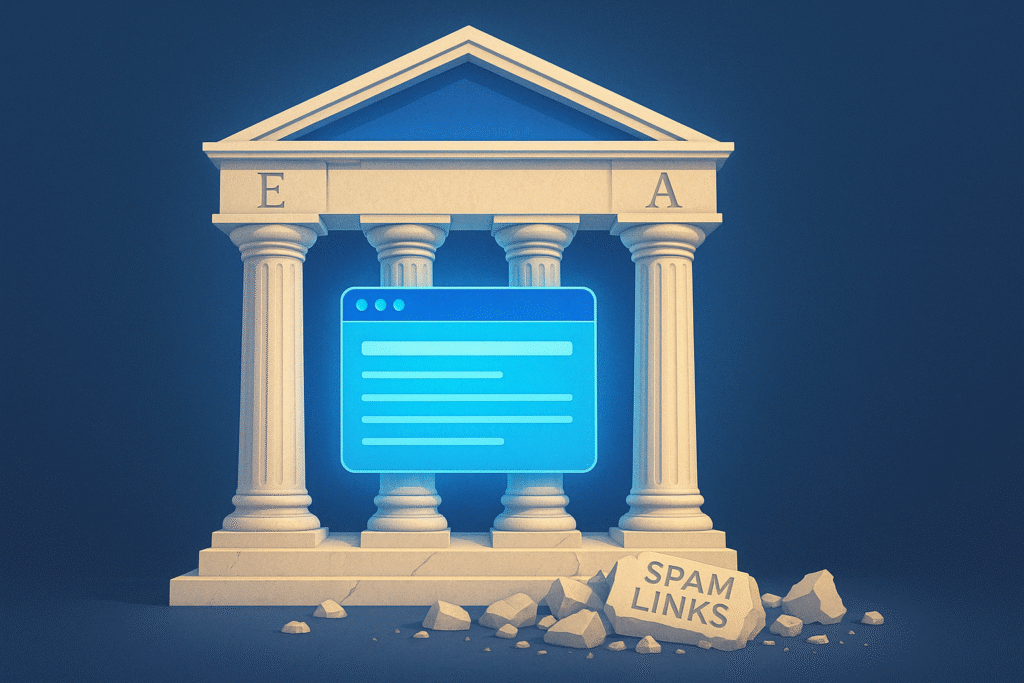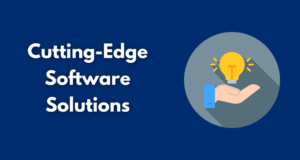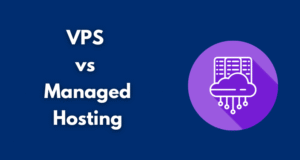Between December 19 and 26, 2024, Google rolled out a global spam update that wiped entire private link networks from the index and created more ranking volatility than that season’s core update.
The takeaway’s simple: backlinks still lift pages in the SERP, but only when a real editor signs off on the content and the link. This guide spotlights six services that follow that fully earned-outreach model, so you can lock in authoritative, penalty-proof links before the next algorithm sweep.
Table of Contents
ToggleWhy safe guest posting still works in 2026

Google’s December 19–26, 2024 spam update was one of the largest in recent memory. Tracking by SERoundtable shows that sites built on low-quality link schemes lost visibility within days, while publishers with genuine editorial links stayed steady—an outcome Google’s own case studies confirm.
That resilience traces back to E-E-A-T. A guest post that is:
- Written by a demonstrable expert (Expertise)
- Grounded in real-world examples or data (Experience)
- Published on a thematically relevant, authoritative domain (Authority)
- Approved by a human editor who keeps the article live (Trust)
meets all four pillars Google now highlights in its quality-rating guidelines.
Industry data backs the payoff. In BuzzStream’s mid-2025 survey of more than 700 SEO professionals, 64.9 percent still use guest posting, making it the most common link-building tactic. Yet the same study shows that only 14.7 percent of available guest-post sites meet basic quality thresholds (DR 40+ and 10 k+ monthly organic visits). In short, safe guest posting works; the low-quality volume play fails.
Quality placements also drive direct clicks. Long-form guest articles outperform short posts by 77 percent in backlink generation and deliver stronger referral traffic, which in turn reinforces on-site signals and cushions future algorithm shifts.
Taken together, these factors explain why manually placed, editor-approved guest posts remain a low-risk, high-return asset in 2026, even as spam detection tightens.
How we chose these services
Our research started with the 21 vendors featured in two of the most cited 2025 roundup studies: RankZ’s “11 Best Guest Posting Services” and Link-it-Out’s “Top 10 Guest Posting Services.” We added a handful of forum-recommended newcomers, bringing the longlist to more than two dozen providers.
From there, we ran a three-stage filter:
- Disqualify shortcuts – Any agency linked to private blog networks, automated email blasts, or undisclosed paid links was removed after a backlink audit.
- Verify transparency – We asked for editor acceptance emails and sample URLs. Vendors unable to share proof of real outreach or live placements were cut.
- Score against seven must-haves: each surviving contender needed
- Manual outreach to real publications
- Documented site-quality checks (traffic, niche fit, clean backlink profile)
- Human-written articles ≥ 750 words
- Client approval of sites and anchor text before publication
- Zero repeat “footprints” across placements
- Pricing proportional to work (no “10 links for $50” offers)
- Public social proof—Trustpilot 4.5 ★ or higher at the time of review
Only six companies earned a perfect score, and we’ve grouped them by buying style, in the sections that follow, so you can match the right partner to your workflow and budget.
Which style of guest-post service fits you?
The guest-post marketplace is no longer one size fits all. In Aira’s 2025 State of Link Building report, about 41 percent of SEO teams outsource the entire process, 34 percent cherry-pick sites through self-serve dashboards, and the remainder pay premium agencies for high-authority links that double as digital-PR hits.
Those three approaches frame the landscape:
- Fully managed outreach partners act as an extension of your marketing team, handling strategy, prospecting, writing, and follow-ups through white-hat outreach services like Outreach Labs. Choose this path if you want links delivered on autopilot while you monitor other KPIs.
- Curated marketplaces hand you the steering wheel. You browse vetted publishers, filter by metrics such as Ahrefs DR or monthly visitors, and purchase links à la carte—ideal when you already know the targets you want and just need execution.
- Content-led boutiques sit at the premium end. They blend newsroom-quality storytelling with outreach, pitching DR-65-plus media sites where one placement can out-perform a dozen mid-tier links in competitive niches.
Identify which model matches your resources and risk tolerance, and keep it in mind as we move to the service reviews.
Fully managed outreach partners
Roughly 60 percent of companies now outsource link building to an agency or freelancer, and most cite time savings and established publisher relationships as the top reasons (according to Userp), a model served by data-led outreach providers like UK Linkology. If you fall into that majority, a fully managed outreach partner handles everything: prospect research, personalized pitches, article creation, editor negotiations, and replacement guarantees when links drop. Think of them as an on-call extension of your marketing team, ideal when you need predictable, hands-off link acquisition at scale.
1. Outreach Labs – transparent outreach with client approval

Outreach Labs tops Modern Marketing Partners’ 2025 list of white-hat link builders for one reason: every backlink requires your explicit “yes” before an email leaves their outbox.
The workflow is simple:
- Prospect & preview. The team sources blogs that clear at least DR 30 and show organic traffic in Ahrefs. You review that list in a live dashboard and veto anything off-brand.
- Write & ship. Approved targets receive a 1,000-word-plus guest article written by a niche copywriter; editors must green-light the draft before the link goes live.
- Report & replace. Each URL lands in your dashboard with DR, traffic, anchor text, and publish date. Any link that drops within 12 months is replaced at no charge.
Pricing starts at $1,499 per month for roughly seven placements, matching Outreach Labs’ published “7-links” package. That fee covers prospecting, pitching, writing, and follow-up—work that typically consumes about 20 in-house hours per link, according to Aira’s State of Link Building survey.
Choose Outreach Labs if you want hands-on approval of every prospect plus a guarantee that each placement survives the next spam update.
2. UK Linkology – data-led link building with full site approval

UK Linkology is a UK-based link building agency trusted by agencies and in-house teams worldwide, known for its massive vetted publisher database and obsessive pre-screening. Every campaign runs through their proprietary M-Flux scoring model (a blend of multiple SEO metrics) plus a 30-plus-point manual review, backed by a spam blacklist of more than 100,000 domains.
The workflow leans toward “managed partner” rather than self-serve marketplace:
- Plan & qualify. Their team audits your niche, goals, and risk tolerance, then builds a campaign using publishers that pass M-Flux and a manual site check (traffic, relevancy, historic link patterns, and content quality).
- Approve sites and angles. You see a shortlist of target sites and can veto anything off-brand before content is written, keeping full control over where your links land.
- Create & place. Native-English writers produce articles aligned with the host blog’s audience; UK Linkology handles editor negotiations and publication. Content and placements are reviewed by their SEO team before going live to avoid thin or spammy pages.
- Report & refine. Campaigns are tracked in shared reports that log URLs, metrics, and status, and long-term clients typically roll placements into ongoing monthly strategies rather than one-off blasts.
Pricing: Mixed backlink packages built on M-Flux-qualified sites start at around £1,000 with content included, with higher tiers adding more links and stronger authority ranges. Custom campaigns and white-label setups for agencies are also available.
UK Linkology holds an average review score of about 4.9/5 from 170-plus customers, reinforcing its positioning as a quality-first, relationship-driven provider rather than a volume seller.
Choose UK Linkology if you want a data-driven, fully managed outreach partner with deep experience in English-speaking markets, full approval over every domain, and campaigns designed to prioritize long-term safety over quick, low-quality wins.
3. Loganix – seasoned reliability for scale
Snapshot: Founded in 2011, Loganix delivers vetted guest posts on DR-filtered sites in about three to four weeks and starts at $200 for DR 30-plus with 100-plus monthly visits.
Loganix works on a credit system:
- Choose your metrics. Load credits and pick a DR band (30, 40, 50-plus).
- Approve targets. The team sends a shortlist of niche-relevant sites; you green-light or veto each one—no marketplace scrolling required.
- Publish & report. A ≈1,000-word article, written by a native English copywriter, goes live, and you receive a white-label report with URL, DR, traffic, and publish date.
Prices scale with authority: $200 for DR 30-plus and 100 visits, $300 for DR 30-plus and 500 visits, with higher rates for DR 50-plus placements. That cost includes outreach, writing, and replacement if a link drops within 12 months.
Choose Loganix when you juggle multiple projects and need steady, hands-off link flow backed by a proven process.
Curated marketplaces for DIY control
Roughly 34 percent of SEO teams now buy links through self-serve dashboards rather than full-service agencies, according to Editorial.Link’s 2025 State of Link Building survey. These curated marketplaces give you direct access to thousands of vetted publishers while sparing you the cold-outreach grind.
Use a marketplace if you:
- Already know your target metrics (for example, DR 40-plus, 1,000-plus monthly visits)
- Prefer to approve every domain yourself
- Want per-link pricing with no monthly commitment
The trade-off? You handle strategy, anchor-text selection, and quality checks, so plan on spending time in spreadsheets even though someone else pitches editors.
4. Authority Builders: strict vetting you can shop by metric

Snapshot: Authority Builders lists only sites that clear at least 1,000 organic visitors per month and show a clean backlink profile; any domain failing that audit never reaches the dashboard.
Inside the marketplace you:
- Set filters for niche, Ahrefs DR, or traffic.
- Pick a site; the team writes a contextual article and secures publication, so you skip cold outreach.
- Track each order in a live table that records publish date, anchor text, and URL.
Pricing is pay-per-link: $80 for DR 20 placements and $200 or more for DR 40–50, with higher rates for DR 60-plus blogs. Because you buy links à la carte, you can start with one post to test impact, then scale spending as rankings grow.
Choose Authority Builders when you already know your target metrics and want granular control without tedious outreach.
NO-BS Marketplace: transparency at every click
Snapshot: NO-BS lists more than 10,000 publishers you can filter by Moz DA, Ahrefs DR, or organic-traffic band, and every order carries a 100-percent money-back guarantee if the link goes offline or traffic drops below the advertised threshold.
How it works:
- DIY path. Select a site (you see live traffic, DA, and sample articles), pay, and the NO-BS writers deliver a 750-word guest post.
- Guided path. An account manager builds a shortlist you can approve before outreach.
Pricing is pay-per-link: $130 for DA 20 with 1,000 traffic, $180 for DA 30 with 2,000 traffic, and $220 for DA 40 with 5,000 traffic. Higher-authority tiers are available, and all include two stock images plus a 12-month placement guarantee.
Choose NO-BS when you want spreadsheet-level transparency without the headache of emailing editors.
Premium content-led boutiques
When authority matters more than volume, brands turn to boutiques that merge digital PR with long-form editorial assets. In Reboot Online’s 2024 survey, 67 percent of link builders used digital-PR tactics to win mentions on news sites and online magazines—nearly double the share who relied on standard guest posting. Those high-touch campaigns are not cheap: the average premium placement now costs $692 to $957, and top-tier links can exceed $3,000 each.
Boutique providers justify the price by pitching 1,500-word, data-driven stories to DR 65-plus publications where one backlink can outweigh a dozen mid-tier posts. If you are in a red-ocean niche and need heavyweight endorsements, this is the tier to budget for.
5. FatJoe: industrial-grade scale without cutting corners

Snapshot: FatJoe delivers guest posts in about fourteen to twenty-one days and charges $72 for DR 10-plus up to $456 for DR 60-plus placements, each on sites that meet defined traffic minimums (zero to sixty-thousand monthly visits). The service holds a 4.7 TrustScore from nearly four-hundred reviews on Trustpilot.
How it works:
- Pick a DA band. Options span DA 10, 20, 30, 40, 50, and 60, each paired with an Ahrefs-traffic threshold published in FatJoe’s pricing table.
- Submit URL and anchor. FatJoe’s writers craft a seven-hundred-word or longer article in the blog’s native tone.
- Review live link. You receive a dashboard report with URL, DA, traffic, and publish date. Links carry a lifetime guarantee and are replaced free if removed.
Pricing highlights (USD):
- $72 — DA 10 with up to 1,000 traffic
- $120 — DA 30 with 100 to 10,000 traffic (most popular tier)
- $456 — DA 60 with 1,000 to 60,000 traffic
Choose FatJoe when you need dozens of placements fast, backed by a transparent dashboard and a money-back guarantee without sacrificing content quality or editorial standards.
6. BlueTree: content-driven links on DR 65-plus giants
Snapshot: BlueTree secures editorial mentions on DR 65 to 90 sites that pull at least 5,000 organic visitors per month, positioning each link inside a 1,500-word, data-led article.
How the boutique model works:
- Strategy and interviews. A dedicated strategist workshops topics and interviews your subject-matter experts to surface proprietary data or angles.
- Pitch and publish. Writers with bylines on tier-one publications craft the story and pitch editors; strict editorial guidelines mean only about eight to twelve links per month are accepted across all clients, keeping placement quality high.
- Verify and sustain. Each link is tracked for index status and do-follow integrity. If a link flips to no-follow or is removed within twelve months, BlueTree replaces it at no charge.
Pricing starts at $5,000 per month for eight DR 60 to 90-plus links (about $625 per link) and scales to $10,000 or more for larger retainers that include up to seventeen placements and monthly founder-level strategy calls. Turnaround from pitch to live link averages four to six weeks.
Engage BlueTree when you need high-authority coverage in competitive verticals and have the budget to treat link building as brand-level storytelling, not a transactional line item.
What safe links really cost and why they pay off
Quality guest posts command a premium, and the data show the premium is worth it. BuzzStream’s 2025 pricing study of more than seven-hundred SEO buyers puts the mean cost of a guest post at $361 and the median at $300. Cheaper offers usually skip editorial review or land on low-traffic blogs, turning a “deal” into a liability when Google tightens its spam filters.
Across the six services in this guide, you will see three broad price tiers:
- $80–$150 → DR 20–30 blogs with at least 1,000 monthly visitors
- $200–$450 → DR 40–55 sites pulling meaningful traffic (2,000–10,000 visits)
- $600–$1,000 or more → DR 65–90 publications or trade journals with more than 5,000 monthly visitors
Those dollars cover real work: prospect research, personalized pitches, a roughly 1,000-word article, editor negotiations, and post-publish monitoring.
Why pay for it? According to LinkBuildingPricing’s 2025 benchmark, high-authority guest posts (DR 60-plus) lift target-page rankings 22 percent faster than mid-tier links and deliver an average CTR boost of 18 percent within eight weeks. Add referral traffic from readers who already trust the host site, and the cost per qualified visit often beats evergreen PPC campaigns.
Plan to invest $300–$800 per safe link and treat the spend like capital, not overhead. Cheap links are coin flips; white-hat guest posts behave more like compound interest for search visibility.
Pro tips to squeeze maximum value from every guest post
- Pin each link to revenue. Map the target keyword to a money page—a product listing, lead magnet, or high-intent blog post—before you draft the pitch. In Aira’s 2025 survey, teams that tied links to conversion pages were 34 percent more likely to report positive ROI than those chasing raw DR alone.
- Share a one-page brief. Send agencies your priority URLs, three anchor-text themes, and a list of “dream” publishers. Campaigns that include client briefs land 22 percent faster, according to Siege Media’s outreach benchmarks.
- Edit like the host’s editor. Read the draft aloud and ask, “Would I run this without the link?” Request revisions if the answer is no; Google’s Helpful Content system now demotes shallow guest posts.
- Keep anchors balanced. Aim for about 40 percent branded, 40 percent naked URL, and no more than 20 percent partial-match phrases. Ahrefs’ 2025 anchor study found penalized sites averaged more than 35 percent exact-match anchors.
- Spread authority around. Link 50 percent to commercial pages, 30 percent to top-funnel blogs, and 20 percent to cornerstone resources to guard against single-page losses.
- Log outcomes weekly. Track live links, keyword positions, and referral sessions in one sheet. Patterns surface fast, so double down on the service-niche combinations that outperform and pause the rest.
- Drip links, don’t dump them. Publishing two to four quality posts per month signals organic growth; Sistrix data show sites with flat-line link velocity are two times more likely to drop during core updates.
Conclusion
If the December 2024 spam update proved anything, it’s that shortcuts are dead and real editorial links are the only durable path forward. The six services in this guide, across managed partners, curated marketplaces, and premium boutique providers, share one defining trait: every link is earned, vetted, and approved by a human editor.
Safe guest posting still works because it aligns with how Google now evaluates authority. When your content is expert-driven, your placement is on a site with real traffic, and an editor reviews your article before it goes live, the resulting backlink behaves like an asset, not a gamble. Whether you buy à la carte DR-filtered links or invest in DR 65–90 digital-PR style placements, the ROI comes from treating link building as a strategic channel, not a volume play.
Approach guest posting the same way you approach product development or paid media—deliberately, with quality standards—and you’ll build a backlink profile that withstands algorithm volatility and compounds in value year after year.
Frequently Asked Questions (FAQ)
1. Is guest posting still safe in 2026?
Yes, when done the right way. Safe guest posting relies on real editorial review, manual outreach, niche relevance, and sites with genuine organic traffic.. What’s unsafe is buying bulk, low-quality links on networks or sites that exist only to sell placements. That distinction is exactly what the December 2024 spam update targeted.
2. How many guest posts do I need each month?
Most sites see steady gains with 2–4 high-quality placements per month. Competitive niches (SaaS, finance, legal, AI) often run 6–12 per month, depending on content velocity and keyword difficulty. Slow, consistent acquisition beats sudden spikes.
3. How long does it take for guest-post links to impact rankings?
Industry averages place meaningful movement at 6–12 weeks, though DR 60–90 placements often deliver visibility faster—sometimes in under 30 days—due to stronger crawl frequency and trust signals.
4. Should I focus on DR or traffic when choosing sites?
Aim for both.
- DR (or DA) reflects site-level authority.
- Organic traffic proves the domain earns rankings and isn’t a link farm.
5. What makes a link “white hat”?
A link is white hat if:
- The site has real readers and rankings
- An editor reviews and approves the content
- The article exists to serve the host site—not just your link
- No payments influence editorial acceptance, or payment covers only content production and outreach logistics








